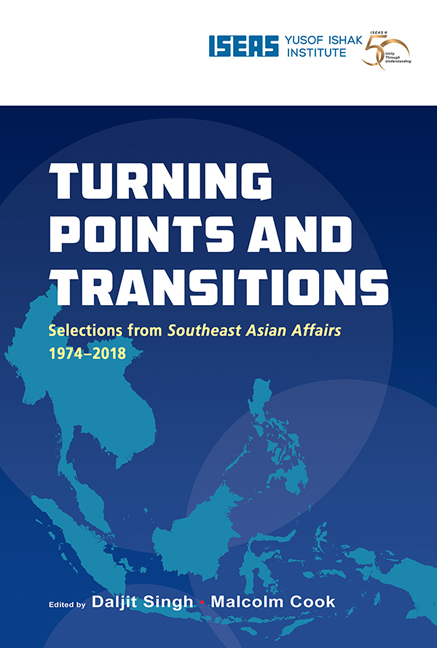Book contents
- Frontmatter
- Contents
- Message from the Director
- Foreword
- Foreword
- Introduction
- THE REGION
- The Diplomatic Emergence of China and Its Implications for Southeast Asia (1975*)
- Stability and Security in the Region after ANZUK (1975)
- The Question of the “Overseas Chinese” (1976)
- Southeast Asia 1976: The Handling of Contradictions (1977)
- The “Fukuda Doctrine” and Its Implications for Southeast Asia (1978)
- Expanding Horizons in Southeast Asia? (1994)
- AFTA in the Light of New Economic Developments (1995)
- The ASEAN Economic Miracle Unravels (1999)
- Southeast Asia in 1999: A False Dawn? (2000)
- East Timor's Future: Southeast Asian or South Pacific? (2001)
- Southeast Asia in 2002: From Bali to Iraq — Co-operating for Security (2003)
- The Year in ASEAN: The Charter, Trade Agreements, and the Global Economic Crisis (2010)
- Seeking Stability in Turbulent Times: Southeast Asia's New Normal? (2015)
- China's Two Silk Roads Initiative: What It Means for Southeast Asia (2015)
- China's International Strategy and Its Implications for Southeast Asia (2016)
- BRUNEI
- CAMBODIA
- INDONESIA
- LAOS
- MALAYSIA
- MYANMAR
- THE PHILIPPINES
- SINGAPORE
- THAILAND
- VIETNAM
China's Two Silk Roads Initiative: What It Means for Southeast Asia (2015)
from THE REGION
Published online by Cambridge University Press: 29 May 2019
- Frontmatter
- Contents
- Message from the Director
- Foreword
- Foreword
- Introduction
- THE REGION
- The Diplomatic Emergence of China and Its Implications for Southeast Asia (1975*)
- Stability and Security in the Region after ANZUK (1975)
- The Question of the “Overseas Chinese” (1976)
- Southeast Asia 1976: The Handling of Contradictions (1977)
- The “Fukuda Doctrine” and Its Implications for Southeast Asia (1978)
- Expanding Horizons in Southeast Asia? (1994)
- AFTA in the Light of New Economic Developments (1995)
- The ASEAN Economic Miracle Unravels (1999)
- Southeast Asia in 1999: A False Dawn? (2000)
- East Timor's Future: Southeast Asian or South Pacific? (2001)
- Southeast Asia in 2002: From Bali to Iraq — Co-operating for Security (2003)
- The Year in ASEAN: The Charter, Trade Agreements, and the Global Economic Crisis (2010)
- Seeking Stability in Turbulent Times: Southeast Asia's New Normal? (2015)
- China's Two Silk Roads Initiative: What It Means for Southeast Asia (2015)
- China's International Strategy and Its Implications for Southeast Asia (2016)
- BRUNEI
- CAMBODIA
- INDONESIA
- LAOS
- MALAYSIA
- MYANMAR
- THE PHILIPPINES
- SINGAPORE
- THAILAND
- VIETNAM
Summary
Introduction
In 2013, Chinese President Xi Jinping announced a pair of initiatives that aims to restructure the economy and geopolitics of Eurasia. The Silk Road Economic Belt announced by Xi Jinping in September 2013 during a tour of Central Asian neighbours is a programme to build land transportation corridors that connect China to Europe and all other major Eurasian subregions, including Indochina, South Asia, and Southwest Asia. Then in October 2013, Xi visited Indonesia and announced the 21st Century Maritime Silk Road, which is a port development initiative to broaden Chinese trade channels targetting the maritime regions of Southeast Asia, South Asia, the Middle East, East Africa, and the Mediterranean. Xi Jinping's two Silk Road programmes are a package called the “One Belt — One Road” [yidai — yilu] initiative.
Both Xi Jinping and Premier Li Keqiang spent great effort in the year 2014 launching concrete measures to advance the silk roads agenda of Eurasian connectivity and regional cooperation. They hope to build a comprehensive trans-Eurasian network of economic corridors that could sustain China's economic growth and strengthen China's political leverage for decades to come. The consequence would be to draw the countries of Eurasia into China's economic orbit to form what Xi Jinping calls a “community of shared destiny”. Members’ fortunes would rise as China's own rise continued. A culturally and politically diverse but economically integrated division of labour harmoniously organized by China's trade and financial interests is what China promises. If this vision is fully realized, China's silk roads vision will help realize “the great rejuvenation of the Chinese nation” and the “China Dream” of a wealthy society grounded on Chinese values.
It should be noted that this yidai — yilu agenda is a work in progress rather than a fully drawn up master plan. That is, as previous Chinese leaders have done, Xi Jinping is providing a grand strategic vision or agenda for China. The Chinese Communist Party and government must work to realize this agenda to the best of their ability. So, for the rest of Xi Jinping's years in power — expected to last until 2022 — we will hear about the two Silk Roads at every meeting that Xi Jinping or Li Keqiang attends in Europe, Africa, the Middle East and Asia.
- Type
- Chapter
- Information
- Turning Points and TransitionsSelections from Southeast Asian Affairs 1974-2018, pp. 150 - 165Publisher: ISEAS–Yusof Ishak InstitutePrint publication year: 2018



